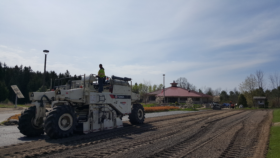
At Crossroads last week, work on our environmentally responsible parking lot resumed, we planted trees, and researchers from UW-Oshkosh moved in to the lab a summer of water quality studies. And, oh, I attended the Climate Change Forum. Curiously, everything related in some way to extreme weather events.
The first speaker at the Climate Change Forum, Dr. Steve Vavrus of UW-Madison, described recent climate changes globally and locally and shared current thinking as to what we can expect in the future. He explained the relationship of climate change to extreme weather. And no, it’s not our imaginations. Instead of the gentle rain we remember from childhoods, more often than not, we seem to have heavy rain that comes down faster and harder. The speculation is that extreme weather events will happen more and more often in years to come.
In addition to the obvious fact that our parking lot is too small to accommodate our visitors, we currently have water issues at the Learning Center, and the Historical Society often has excess water in their Heritage Village at Big Creek. Our upgraded parking lot was designed to allow for water infiltration even during extreme storms and to filter out most pollutants before they reach surface or ground water.
Furthermore, as an extension for the parking lot project, we hope to restore our land to its original drainage patterns by replacing our ponds with a series of swales…a chain of small temporary ponds which will channel water away from the buildings and while improving the habitat for wetland creatures.
We’ve planted a lot a trees this spring and when we landscape our parking lot and swales, we will plant hundreds more. Most people have heard the standard benefits: that trees release oxygen, that trees save energy, that trees reduce atmospheric carbon dioxide, that trees increase property values and improve air quality. All true!
But in Door County, one of the most important benefits of trees is that they improve our water quality. Most of us are aware and annoyed (to put it mildly) by the increase of weeds and algae in our bays and on our lakeshores. Aquatic vegetation has proliferated due to a combination of circumstances, but nutrients and soil which are washed into the water during storms certainly play a major role.
Where tree canopies slow the raindrops as they fall, soil erosion is significantly reduced. Rain drops are caught by the leaves, and then, after the storm, the droplets gently fall whenever the breezes blow. Thus, trees reduce the amount of soil and phosphorus which otherwise would be washed into the water.
Furthermore, during pelting rainstorms–what we aptly call “gully-washers”— the raindrops literally fracture as they hit the tree leaves, and the resulting mist is far more likely to be absorbed by the soil.
We know that pollutants—both chemical and microbial—are washed from the land into the water. We know that, I’m proud to say, because for more than a decade, researchers from UW-Oshkosh have been taking water samples at the beaches of Door County and then testing the samples for E. coli and sometimes for specific pathogens in the lab at Crossroads. Almost always, when researchers have had to close beaches for health reasons, the spike in microbes has followed an extreme rain event.
The bad stuff is not washing up from Milwaukee or Chicago. Our water pollution comes from our land and is washed into the water during storms.
Because of this research, several beaches in Door County have been redesigned to reduce the amount of pollution which enters swimming areas. This is good. Better would be to keep pollutants off the land entirely. We aren’t there yet, but know that water samples will be collected at area beaches and analyzed at Crossroads again this summer.
Crossroads at Big Creek is a donor supported facility made up of the Big Creek, The Cove, and the Ida Bay preserves. The Collins Learning Center, located at 2041 Michigan just east of the Highway 42/57 Roundabout in Sturgeon Bay, is open 2:00-4:00 daily and during scheduled activities. Trails in all preserves are open 24/7 free of charge.
Parking lot construction is underway. If our parking lot is closed, please park at the Maintenance Building (across from Whitetails) or at the Astronomy Campus lot (turn left at the Utah Street/Cove Road intersection.)
Saturday, June3,
1:00 Wildflower Walk along Big Creek
Last fall, we developed multi-use winter trails parallel Big Creek. Because these trails travel through “new territory” we have no ideas what wildflowers we may (or may not) find. This one-hour walk of discovery may help us add species to our plant inventory. The one hour walk will be gentle and is free and open to the public. Meet at the Astronomy Campus Parking Lot.
Sunday, June 4 1:00 Hike on Lilac Ridge A massive invasive species eradication effort last summer opened two new trails overlooking the Big Creek Valley. This hike will offer a new vista the preserve and let us observe the first stages of habitat recovery. About an hour. Meet at the Astronomy Campus Parking Lot.

